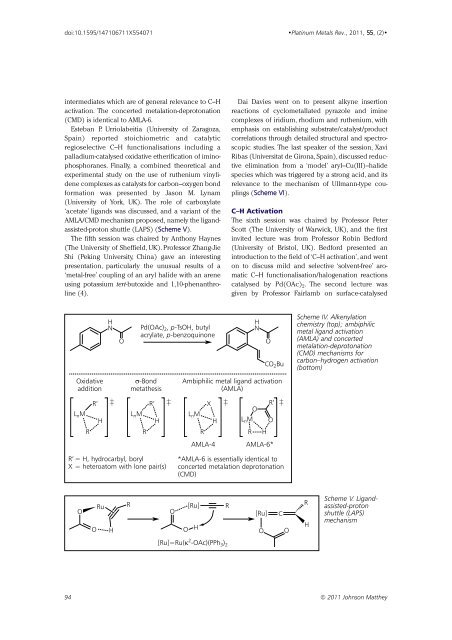Download - Platinum Metals Review
Download - Platinum Metals Review
Download - Platinum Metals Review
You also want an ePaper? Increase the reach of your titles
YUMPU automatically turns print PDFs into web optimized ePapers that Google loves.
doi:10.1595/147106711X554071<br />
•<strong>Platinum</strong> <strong>Metals</strong> Rev., 2011, 55, (2)•<br />
intermediates which are of general relevance to C–H<br />
activation. The concerted metalation-deprotonation<br />
(CMD) is identical to AMLA-6.<br />
Esteban P. Urriolabeitia (University of Zaragoza,<br />
Spain) reported stoichiometric and catalytic<br />
regioselective C–H functionalisations including a<br />
palladium-catalysed oxidative etherification of iminophosphoranes.<br />
Finally, a combined theoretical and<br />
experimental study on the use of ruthenium vinylidene<br />
complexes as catalysts for carbon–oxygen bond<br />
formation was presented by Jason M. Lynam<br />
(University of York, UK). The role of carboxylate<br />
‘acetate’ ligands was discussed, and a variant of the<br />
AMLA/CMD mechanism proposed, namely the ligandassisted-proton<br />
shuttle (LAPS) (Scheme V).<br />
The fifth session was chaired by Anthony Haynes<br />
(The University of Sheffield, UK). Professor Zhang-Jie<br />
Shi (Peking University, China) gave an interesting<br />
presentation, particularly the unusual results of a<br />
‘metal-free’ coupling of an aryl halide with an arene<br />
using potassium tert-butoxide and 1,10-phenanthroline<br />
(4).<br />
Dai Davies went on to present alkyne insertion<br />
reactions of cyclometallated pyrazole and imine<br />
complexes of iridium, rhodium and ruthenium, with<br />
emphasis on establishing substrate/catalyst/product<br />
correlations through detailed structural and spectroscopic<br />
studies. The last speaker of the session, Xavi<br />
Ribas (Universitat de Girona, Spain), discussed reductive<br />
elimination from a ‘model’ aryl–Cu(III)–halide<br />
species which was triggered by a strong acid, and its<br />
relevance to the mechanism of Ullmann-type couplings<br />
(Scheme VI).<br />
C–H Activation<br />
The sixth session was chaired by Professor Peter<br />
Scott (The University of Warwick, UK), and the first<br />
invited lecture was from Professor Robin Bedford<br />
(University of Bristol, UK). Bedford presented an<br />
introduction to the field of ‘C–H activation’, and went<br />
on to discuss mild and selective ‘solvent-free’ aromatic<br />
C–H functionalisation/halogenation reactions<br />
catalysed by Pd(OAc) 2 . The second lecture was<br />
given by Professor Fairlamb on surface-catalysed<br />
H<br />
N<br />
O<br />
Pd(OAc) 2 , p-TsOH, butyl<br />
acrylate, p-benzoquinone<br />
H<br />
N<br />
O<br />
CO 2 Bu<br />
Scheme IV. Alkenylation<br />
chemistry (top); ambiphilic<br />
metal ligand activation<br />
(AMLA) and concerted<br />
metalation-deprotonation<br />
(CMD) mechanisms for<br />
carbon–hydrogen activation<br />
(bottom)<br />
Oxidative<br />
addition<br />
σ-Bond<br />
metathesis<br />
Ambiphilic metal ligand activation<br />
(AMLA)<br />
L n M<br />
R<br />
R’<br />
H<br />
+<br />
L n M<br />
R<br />
R’<br />
H<br />
+<br />
L n M<br />
R<br />
X<br />
H<br />
+<br />
L n M<br />
R<br />
O<br />
H<br />
R’<br />
O<br />
+<br />
AMLA-4<br />
AMLA-6*<br />
R’ = H, hydrocarbyl, boryl<br />
X = heteroatom with lone pair(s)<br />
*AMLA-6 is essentially identical to<br />
concerted metalation deprotonation<br />
(CMD)<br />
O<br />
O<br />
Ru<br />
H<br />
R<br />
O<br />
O<br />
[Ru]<br />
H<br />
R<br />
[Ru]<br />
O<br />
C<br />
O<br />
R<br />
H<br />
Scheme V. Ligandassisted-proton<br />
shuttle (LAPS)<br />
mechanism<br />
[Ru]=Ru(κ 2 -OAc)(PPh 3 ) 2<br />
94 © 2011 Johnson Matthey
















